Their happenings caused them to be ejected from the museum - when some people complained that they had had fallen after tripping over the wire.
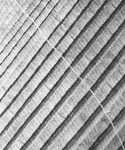

Part 1
Chaos & disruption - Great and small
1950 – Guy Debord and Isidore Isou disturbed the Easter-mass in the Notre Dame in Paris. They were disguised as monks and their action caused an international scandal. Later in 1951 they disturbed the film festival in Cannes to force the showing of Isou’s films.
| 1962 - Jiro Takamatsu exhibited a string that was
1000m long and that extended from the museum far out into
the city. Their happenings caused them to be ejected from the museum - when some people complained that they had had fallen after tripping over the wire. |
 |
 |
1963 - Akasegawa Genpei (Japan) ordered mechanical reproductions of the 1,000 yen note, to be used in performances and announcements. The artist's desire to interact with society backfired, however, as he was arrested and tried for currency fraud. The guilty verdict against Genpei left a complex and ambivalent lesson for the definition of conceptual art in Japan.
1963 > Since 1963 Pierre Pinoncelli, a follower of the Nice artistic movement, has organized more than 70 Happenings, among them:
| 1964 - A series of Confrontation Events by the Czech artist Milan Knizak: |
|
| 1966 - Michelangelo Pistoletto made a 1m high sphere out of "papier mache" and took ik with him everywhere he went. Also into bars and cafes. It allowed the artist to redirect social interactions". | 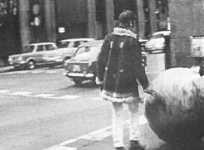 |
1967 - Abbie Hoffman disrupted the New York stock exchange on August 1967. With a group of twelve individuals he threw dollars at the traders from the overhanging balcony of the exchange floor; an action that stopped trading for a few seconds when the brokers lunged to grab the money. http://www.mightymedia.com/EarthDay97/center/text/webstock19.htm
1968 - Valie Export (a lady) appeared on the street with a miniature puppet-theatre stage constructed around her bare, but hidden, breasts. Using a bull-horn she invited the public to step up, reach through the curtains and touch her breasts (Tapp und Tastkino).
1969 - Valie Export dressed in pants with the crotch cut away and a machine gun slung over her shoulder entered a pornographic cinema in Munich. Adressing the audience that had come to watch genitalia on the screen she announced that "real" genitalia were available and that they could do whatever they wished. The people left the theatre. (Genital Panic).
1969 - Vito Acconci acted out "Following Piece" as part of "Street Works IV". This piece consisted of Acconci following randomly chosen individuals, abandoning them once they left the street to enter a building. It was an invisible artwork because the people were unaware that it was going on.
1969 - The Guerrilla Art Action Group removed Kazimir Malevich's White on White from a wall at The Museum of Modern Art in New York, temporarily replacing it with a manifesto listing demands for Museum reform.
1970 - Artur Barrio made horribly suggestive objects and placed them outside the museum, deposited them in the streets and along the river banks - cloth, bound with string, bulged with human detritus (blood, fingernails, hair, spit, urine, shit, bones), toilet paper, old newspaper, bandages, food scraps etc.
1970 - Joshua Neustein travelled troughout Israel and made tape recordings of water flowing from all the country's natural sources. Then he intended to play the sound of flowing water in a dry valley. He laid electrical cord over the hillside and to these he attached polysterene cups to act as loudspeakers. The day before the start of the project he was arrested by Israeli police who thought he was laying bombs in the landscape.
| 1970 - Terry Fox explains in an interview: | In front of the museum was a large garden of jasmine plants, which bloom once every seven years. They had been growing for six years and were due to blossom soon. During the opening of the exhibition Fox cremated these plants with a flame-thrower of the type used in Vietnam to provide the wealthy people who regularly enjoyed the garden with a concrete example of the type of action they supported with their dollars and their complacency. I burned the whole thing with a flamethrower, and it just left a slight border of these plants, and they ended up having to dig them all out, it destroyed them. So, then, the next day when these people came to have their lunch there, it was just a burned-out plot, you know. I mean, it was the same thing that they were doing in Vietnam. Nobody would get excited about napalming Vietnam, but you burn some flowers that they like to sit near, and it's like ... (Defoliation, University Art Museum, Berkeley, California) |
| 1970 > When André Cadere arrived in Paris from Rumania he was an unknown in the local art scene. Because he had no access to galleries he started using the public space for his artworks. At first he made graffiti. Later he organized "Promenades" where he would walk in public space holding one of his staffs. - But he became best known for his uninvited appearances at exhibitions of other artists. His presence upset the seamless structure of institutions in the art world, did not depend upon galleries, liberated the art object from passive contemplation, and created "situations" when his presence was unwelcome. Like a parasite he would present his work - 3m long round cylinders, decorated with parallel stripes of color - in other people's galleries. This irritated both his art-colleagues and the gallery owners. But his name became well known quickly. He also made long walks with one of his cylinders on his shoulder and meticulously recorded the route he took through the Paris streets. During an exhibition of his work in Turin he copied the adress-file of the gallery and visitied - uninvited - all the people that were mentioned in it. He promised to carry one of his staffs from Paris to Kassel, for the Documenta 5, but instead he came by train. This led to his exclusion from the exhibition, but again it gave him a lot of attention. |  |
 |
1971 - Chris Burden did Shout Piece at F-Space gallery. He sat on a platform 14 feet above the floor, covered with red body paint and illuminated by movie lights. When the people who had received invitations to the exhibition got there, they were surprised by Burden's voice, which was amplified by three large speakers, repeating over and over again: "Get the f*ck out imediately. Get the f*ck out immediately. " Faced with physical rejection and with the artist's own presence, most left instantaneously.
| 1971 - Vito Acconci sat three hours blindfolded in a chair at the foot of the basement stairs, equipped with two lead pipes and a crowbar. Hypnotising himself into a an aggressive psychological state of "possession obsession", he threatened to bash anyone who dared to slip past him in the narrow passageway. Upstairs, on the street level of the loft, a video monitor, showing him live, was placed next to the door leading to the basement. The video monitor served as a warning device to visitors. They could see and hear me, and from that they could decide whether they wanted to open the door and go down to the basement. (Claim Excerpts, basement of 93 Grand Street in New York) | My own talk should drive me into a state where
everything is possible. If I had hit someone during the first hour, I'm sure I would have stopped, incredibly shocked. But by the third hour, if I had hit flesh, that would have been the sign that 'this is where I have to keep hitting. I developed a real devotion to this abstract principle of exclusion. |
1971 - Gottfried Bechtold made a concrete cast of a Porsche 911 and parked it in front of a gallery in Bregenz. The artwork, weighing 13.000 kg, irritated a large section of the public. The concrete car has since accompanied the artist, and is regularly parked in front of the galleries that house his exhibitions. (Beton-Porsche) In another project he practiced "creative driving" by ignoring "one way" signs and driving in the wrong direction on roundabouts. (Aus der Straßenmappe) He also grew grass and weeds on old military vehicles and designed a pyramid for a Mercedes 300 SL.
| 1972 - The Brussels group Mass Moving threw plastic materials on to the spectators and tried to transform them into a sculptural group (picture from: Graz, Austria). |  |
| 1972 - Virgil Ghinea organised
a two-day procession by all the townspeople, with the
artist bearing a green plastic net ten metres long and
eight metres wide. In this net lay a life-size woman made
of plastic. The spectators walked past the net, sat down,
talked about art or touched the dummy. His two principal mottoes for this occasion were: 'it is not important if I listen to you; it is unimportant if I pay attention to you; what is important is that you should begin to speak.' And: 'Art is in every one of us and every one of us can create it.' |
 |
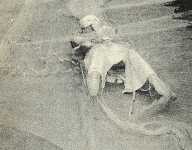 |
1974 - Wolfgang Flatz is a specialist in using bad
taste to create uproar. For example by calling his dog
"Adolf Hitler" he was able to make enemies on
both the extreme right and the extreme left. And he was
able to publish a picture-book about this dog called
"Hitler - A dog's life". A short time ago
Hitler was castrated and his balls are conserved in
fomaldehyde. Other examples of his cultivated bad taste
are:
|
 |
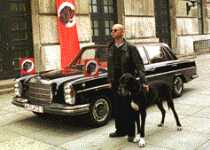
|
1977 ? - Ulay (the partner of Marina Abramovic) stole a valuable painting from the Nationalgalerie in Berlin and hung it in the home of a Turkish "guest worker." A video was made of this event where news reports of the "crime" are intercut with Ulay's description and surveillance-like documentation of the performance Action.
| 1979 ? - Excerpt from interview with Monte Cazazza: | I used to make fake mannequins and leave them all over. I'd dress them up like bag ladies or winos, and put cheap tape recorders inside them playing 6-second endless loop cassettes of people muttering to themselves, etc. Late at night people would think they were real, and sometimes go up to them and try to mug them or something, while I watched across the street, laughing. | I also used to throw these large dolls into dumpsters with a tape recorder playing an endless loop cassette of a baby crying. People would think there was a baby at the bottom, and jump in and toss out all this garbage trying to find it! |
1983 - When the Strathclyde Regional Council withdrew the tax-relief on his garden temple the artist Ian Hamilton Finlay refused to pay up. To enforce their rates assessment, the Council sent a sheriff's officer to seize works of art. On his first visit, the officer's car was barricaded in a "tank trap," and he retreated over the moors on foot. When he returned later in the day with the police to retrieve his vehicle, an imitation Panzer Mk IV erupted in a ball of fire and black smoke. He finally gained access to the garden temple, only to discover that the art works intended for seizure had been removed and hidden. Video and still cameras recorded the action, while Scottish radio ran a live commentary. Finlay's forces were less successful a month later when the sheriff's officer returned to take a sculpture valued at 5,000 pounds, which was consigned to Christie's for sale.
1984 > A doodle on a napkin by J.S.G. Boggs looked very much like a $1 bill. The waitress liked the artwork and accepted it as payment for a cup of coffee worth 90 cents. As he was going out the door, she said, "Wait!" -- and brought him a silver dime in change. The artist had paid with a drawing of a dollar bill and received change. Since then Boggs has been paying many bills with his "art fake" money and has turned this activity into an ongoing performance.
1990 > Artists Thompson and De Luna started sending letters to themselves using their own fake stamps. Since then, they have made about 500 different stamp designs. The artists have proven that essentially any image gangsters like Al Capone, pharmaceuticals such as Prozac and even genitalia and guns) can pass as real postage if they use the necessary text (i.e., "USA" and "32 cents"). http://hotwired.lycos.com/gallery/96/33/profile.html - http://hotwired.lycos.com/gallery/96/33/index4a.html
1990 ? - Everyone has seen a lamppost with a bicycle tyre around it's base. Obviously someone threw the tyre over the top of the lamppost ... The German artist Andreas Slominski approached this situation in an original way. He enlisted the co-operation of the authorities and pulled a lamppost out of the ground with a crane. Then he laid the tyre on the ground and lowered the lamppost again. A very complicated way to reach a perfectly commonplace result.
| 1995 - Hong Kong artist Young Hay made the performance series "Bonjour Young Hay - After Courbet". This project is inspired by Malevich's White-on-White painting and intends to insert blankness into the city's colourful streets. Carrying a white canvas as he drifts through the city , he tries to interrupt busy street life, especially near political monuments. He records his wanderings through photographs made by friends. |  |
| 1995 > The Surveillance Camera Players are staging simple street theatre in front of surveillance camera's and web cams to protest the use of surveillance cameras in public places. Since the group's founding in 1995 the Surveillance Camera Players no longer consider their primary audience to be the police officers and security guards who monitor the surveillance cameras. Today, the SCP concentrate on the people who happen to walk by and see one of their performances. | 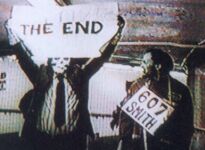 |
| The Surveillance Camera Players are also giving Surveillance Camera Outdoor Walking Tours of heavily observed neighbourhoods in Manhattan, New York City. Each tour includes a general introduction to the emerging surveillance society as well as a choice selection of video cameras that guard public space. Each tour lasts about 60 minutes and is undertaken rain or shine. Their activities have spawned followers all over the globe. For example in Stockholm. - http://www.notbored.org/the-scp.html - http://www.notbored.org/scowt.html - http://www.notbored.org/change.html - http://sot.smufsa.nu/index.html | 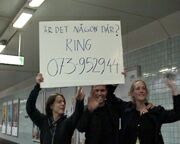 |
1996 - Andrea Lange travelled through several large European cities. In every city she asked random passersby to kiss her. Photographs were made of these performances. Andrea Lange interprets art as "social interaction". In this project intimate situations were made public. The "Kiss me" project comments on human communication, but also on the role of the artist in society.
| 1997 - Tagny Duff is a Vancouver based interdisciplinary visual artist working primarily in performance and video. Since 1997 she has worked extensively on a performance art series entitled Elephantiasis Ears. In her performances Duff often incorporates strategies of intervention, civil disobedience, surprise guerrilla tactics, and a type of vandalism where the body interjects itself into various urban spaces in unusual and unexpected ways. --- She did a performance in a shopping center. It consisted of lying naked on the floor and triggering sound-fragments through electrodes attached to her body. But the guards came, covered her with a blanket and spoilt her performance. |  |
1997 - The Berlin duo p.t.t.red announced that the German terrorist Ulrike Meinhof would be speaking about her 1972 arrest in Langenhagen, a small city near Hannover. On the appointed day they erected a fake rostrum in the market square and in the evening they put it in the spotlights for one hour. Ulrike Meinhof, who died in prison in 1976, did not show up in person but was remembered by the 80 or so people who had gathered in the square. And a chapter of German history, which had been taboo for 25 years became the main theme of discussion in the media. - www.members.aol.com/pttred/art/zen.htm
1998 - Andreas Slominski stole a bicycle-pump from someone's bicycle in Berlin (according to his own account). Then he exhibited the object in the "Deutsche Bank & Solomon Guggenheim Foundation". The object was called "Stolen Bycicle Pump". Then Dr. Jörg Janzer - in his turn - stole this artwork. He made his theft very conspicuous by showing the object to the surprised visitors before running away with it. Out in the street he was overtaken by one of the museum-guards.
| 1999 > Iepe T.B. Rubingh (Rotterdam, Netherlands)
confronted the whole Japanese nation with it's herd
instinct with Keep Out!-tape. On 11 March 2000 at 9 AM he
closed off the Hachiko Crossing, the busiest Crossing in
Tokyo and realised his artwork "I Am Sorry Mister
Emperor, But This Is Funny Said The Joker". In 45
seconds the crossing was taped off, causing a huge
traffic jam. Iepe jumped around in his striped Joker
suit: "The Joker is allowed to make jokes about the
king but he is never in the position to influence the
king's thinking." He was detained by bemused police
for 12 days and fined 50,000 yen. The artist had executed an obstruction in Berlin in 1999. He simply chose those spots where at a certain time (rush hour) a slight delay of cars passing by would lead to a total chaos. In Tokyo he used the Joker motif to attract attention to himself and to distract attention from his Japanese accomplices. He assumed he would be less severely punished than native Japanese so he wanted the police to see him and ignore the accomplices. In each city the performance will use six elements: an intersection, traffic, the public, barrier tape, a group of performers and the police. At a given moment the performers will start the art piece by blocking the road with the barrier tape. In a short time a chaotic structure will come into existence, which will stop the traffic, will interfere with the public and will force the police to react. "Schön geworden" sagte der Narr zum König, "fast fertig" "wäre es nicht schön, wenn Kunst gefährlich wäre?" - 1.10.1999 Hackescher Markt, Berlin - 11.3.2000 Shibuya Square, Tokio |
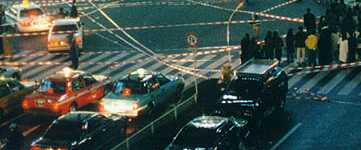
http://www.assemblylanguage.com/images/Rubingh.html |
1999 > Tom Sachs exhibited two working guns as part of his "Haute Bricolage" exhibition. There was also a bowl full of bullets that visitors could take home. Art dealer Mary Boone was arrested at her gallery on Sept. 29 for displaying these objects. Misdemeanor weapons charges were filed by New York City police but were dropped later. http://contemporaryart.about.com/arts/contemporaryart/cs/scandals/index.htm
| 1999 - Vaissier (a Dutch artist) drew a lot of media attention with his plans for the disposal of nuclear waste. He designed a small container that could hold 1 kg of radioactive waste. It was small enough to be buried in anyone's private garden. The disposal of radioactive waste costs 30.000 NLG per kilogram. So a private person could be paid 20.000 NLG to host one disposal unit on his private property. This project was presented as a serious proposal, not as an art project. (ISO-9001) |  |
| 2000 - Spencer Tunick’s performances encompass
dozens, hundreds, and even thousands of volunteers, and
his photographs are records of these events. Most often
grouped together and lying prone, the individual bodies
become one large organism that extends into and upon the
landscape. These grouped masses - which do not underscore
sexuality - challenge or reconfigure one’s views of
nudity and privacy. His work also refers to the complex
issues of presenting art in permanent or temporary public
spaces. Spencer Tunick’s body of work may come to define or at least begin to clarify the social, political and legal issues surrounding art in the public sphere. Since 1998 Tunick has tried to work in New York City without interference or arrest. In May 2000, the artist won his First Amendment right in the Second U.S. District Court. On June 3, in response to a direct appeal made to Justice Ruth Bader Ginsburg and the court at large, the United States Supreme Court refused to rule in favor of New York City, allowing the artist to organize his work on New York City streets. |
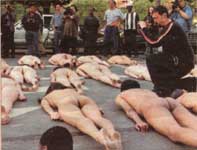
"SIGN UP TO POSE for a performance by Spencer Tunick. Spencer is currently building a database of volunteers for future projects. Please specify your city, state, country, email address and phone number (optional) - Send your mail to: nakedpavement@hotmail.com |
2000 - Jasper van der Made, an artist from Rotterdam has covered part of his painting that he exhibited at the CBK gallery. He had changed the logo of the well know hifi/audio-warehouse "Correct" into "Corrupt". The warehouse was not amused and threatened to sue him. However, many Rotterdammers use the nickname "Corrupt" when they refer to this shop. Not because they don't like the shop - it's famous and prospering - but because Rotterdammers like nicknames. And these aren't always friendly and tasteful.
| 2000 - Peter Klashorst, a Dutch painter, was arrested and jailed in Senegal for making "pornographic" paintings of his wife and girl-friends. He spent 3 weeks in an overcrowded dirty cell. Details of his escape are secret, but it is probable that his 80-year old father bribed some authorities and arranged his escape. | His father had escaped from a German concentration camp and he trained his son Peter in survival techniques. For example, when they visited a football-match his father said "I'll see you inside". And Peter had to improvise a trick to get in without ticket. This training paid off, and Peter claims that he once made a flight from New York to Brussels without a ticket. | The first time Peter Klashorst work became well known was during the reign of the RAF in Germany. He painted a picture of guards arranging a mock suicide of jailed terrorist and exhibited it in the city-square together with a fake bomb, a cardboard box and some wires. Their action was taken more seriously than they expected. www.peterklashorst.nl |
| 2000 - Berlin sculptor Christian Hasucha caused an outrage in the local press (Kölner Stadtanzeiger). Together with a professional archaeologist he selected two square areas (5*5 meters) in Pulheim and Ortsteil Brauweiler. He measured and documented the areas meticulously and then he switched them. The switch included the asphalt, the grass, a piece of fence and garbage tins. Every object was numbered and restored to it's "original" location. Local citizens were outraged about the cost of this "silly" project. The costs amounted to 10.000 D-Mark, the artist asked no monetary reward for his work. (Pulheimer Rochade) http://www.inger.de/verbindungen/unterkuenfte/hasucha/pulheimer_rochade.html | 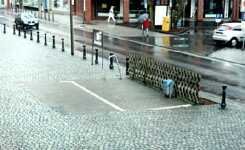 |
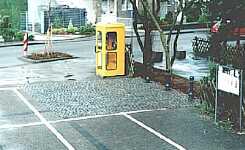 |
2000 - Claudia Rogge placed a garbage container in a city square in Düsseldorf. On the first day several homeless persons stayed in the container. The next day a row of pigs-heads were sticking out of the container. The public reacted indifferently to the people in a garbage-container - just like they did to the idea of treating homeless people as garbage (for example by passing laws forbidding begging in the city). But the authorities reacted promptly to the pigs-heads. The performance was forbidden and the installation was forcefully removed by the police. www.claudia-rogge.de/restposten.htm
| 2001 - Francis Alÿs bought a handgun and walked armed through the streets of Mexico city for the longest possible time. Because the gun was clearly visible in his hand he was eventually arrested by the police. This event was filmed life. Then a re-enactment of this event was staged and filmed. Both video's are presented side-to-side confronting the act and its representation. (Re-enactment) - http://www.wdw.nl/ENG/text/projects/alibis/alys.htm |  |
 |
2001 - Claudia Rogge and Mike Neubauer staged a series of performances inspired by newspaper headlines. Some of these were stopped by the police and further performances were forbidden. The artist however ignored this. The ones most relevant are:
2002 - A group of artists called Critical Art Ensemble invite their audience to synthesise their own transgenic DNA and release it into the air. The idea has worried the officials of the University of Washington - where the opening night of theshow was held in April 2002. They've forbidden the group from giving audience members a vial of transgenic DNA to take home. And they're were not sure whether the performance would be allowed at all.
1950 ? > The surrealist poet Andre Breton once suggested that people who attack artworks with acid should be awarded a prize for their actions. Since then only deranged souls have attacked artworks with knives (Who's afraid of red, yellow and blue), hammers (Michelangelo's Pieta) and acids (Grunewald Altarpiece). But now some graffiti-writers have joined their ranks. In 1992 two artworks were "improved" with spray-paint while hanging in the Berlin Spandow-Gallery. The damage amounted to DM 7000.
| 1962 - Robert Watts's designed several interesting, minimal performances: |
|
1963 - Mieko Shiomi designed the following performance: "A violin is suspended with rope or ribbon inserted through pulley at top and secured to floor. A performer in samurai armour positions himself under suspended violin, draws his sword and cuts the rope in front of him, releasing the violin, which falls onto his helmeted head. (Event for the Late Afternoon)
1963 - Wolf Vostell (Germany) proposed that crashed cars should be fixed to the street in the place where they crashed. The accumulated artworks would eventually bring all the traffic to a standstill. Other actions were:
| 1963 > Throughout his career, Ed
Ruscha has been interested in the mapping and
documentation of location. Early in his career he made
books that presented Twenty six Gasoline Stations [1963],
Some Los Angeles Apartments [1965], Every Building on the
Sunset Strip [1966], and 34 Parking Lots in Los Angeles
[1967]. The Royal Road Test [1967] is one book in this series. It describes a forensic analysis of the effects of hurling a manual typewriter out the window of a 1963 Buick travelling at 90 mph. Several pictures show the scene of strewn wreckage on the shoulder of a road running through the Las Vegas desert. And they show the exact distance the wreckage travelled. (Figure in foreground points to impact area. Figure in background stands at farthest point of wreckage, 189 feet from point of impact.) http://search.famsf.org http://www.artscenecal.com/ArticlesFile/Archive/Articles1998/Articles1298/ERuschaA.html http://www.laweekly.com/ink/00/31/art-harvey.shtml |
 |
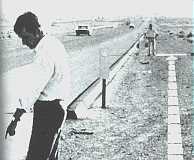 |
1966 - John Latham took a copy of the book "art and culture" from the library - had his students chew the pages of this art-book - distilled the pulp and then returned the book in liquid form in a flask. He was dismissed from his teaching post.
| 1966 - Fruit in Three Acts - a performance by Ken Friedman: |
|
| 1968 - Bernard Aubertin makes and ignites his "Books to be burnt". In his own words: On almost every page, I have stuck or pressed in horizontally rows of ordinary matches, detonating matches, snowy matches, sachets of fragrant smoke generating powder, sticks of fulminate and percussion caps. The spectator / participant may, if he wishes, burn the whole work in one shot by throwing it into a previously lighted fire. But, as all will agree, it is much more interesting to recreate the pyromaniac activity on every page. (Livres á Brûler) | The book, whether burnt, or still to be burnt is a magic object destined to sharpen our perception. The participant is mistreated: he suffocates, his eyes end his nose smart, he is hot, congested and accidentally he burns himself. But he is also fascinated, and sorry when the fire dies down. |
1970 - Partially Buried Woodshed (Kent State University) was a piece Robert Smithson created on site during an invitational arts festival. He located an abandoned woodshed and poured earth on to the structure until it cracked. This work is a prime example of Smithson's visualisation of entropy and time, leaving it to be "subject to weathering, which should be considered part of the piece". This quote is from a statement Smithson signed when he donated the work to Kent State University.
| 1973 - Mary Lucier recorded a sequence of seven sunrises over New York's East River on video. As the sun rose, it's light exceeded the maximum allowed intensity of the picture tube and etched a permanent scar in it's light-sensitive surface. Each day a new scar was added to the previous ones as it followed the ever changing path of the sun across the sky. The work is shown on seven monitors, each marked with an additional burn from the preceding day. (Dawn Burn) In Birds Eye (1978), she aimed a laser directly at the camera's eye, burning the Vidicon tube. She then changed the focal length of the lens and moved the laser, all in an attempt to 'record' changes in light, thus associating her technological work with the Impressionists' observations of light. The resulting configurations, accompanied by Alvin Lucier's electronic score Bird and Person Dying, become an abstract calligraphy of light. | 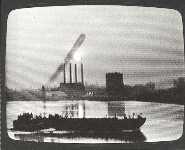 |
| 1973 - Robert Rauschenberg first burnt and then re-bound and signed a book. (Burned book) | 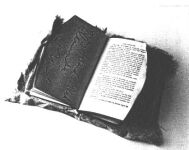 |
1974 - Gary Hill thought of his first video installation, Hole in the Wall, as a transition from sculpture to video. He taped himself knocking out the wall of a gallery and projected the tape on a monitor placed in the wall opening. Where a sculpture might have been, he placed the video memory of a performance.
| 1975 - Ant Farm presented Media Burn at San Francisco's Cow Palace. A "Phantom Dream Car", a reconstructed 1959 El Dorado Cadillac convertible, was driven through a wall of burning TV sets. Footage of the actual event, much of which was shot from a closed-circuit video camera mounted inside a customized "tail-fin," is framed and juxtaposed with news coverage by the local television stations. The spectacle of the Cadillac crashing through the burning TV sets became a visual manifesto of the early alternative video movement. | Who can deny that we are a nation addicted to television and the constant flow of media? Haven't you ever wanted to put your foot through your television? | 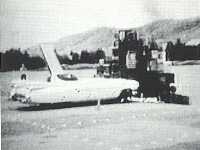 |
1980 - Christian Hasucha looked for holes in asphalt or concrete road surfaces. He filled them with water and the shaped their outlines of the holes by melting the asphalt or by chiselling the concrete. In this way he created artworks that were mostly invisible. They only became visible for a while after a rain shower. (Installations)
1987 > Huang Yongping tossed two canonical art books into the washer, extracted the undifferentiated mass of soaked pulp, and mounted it on a piece of broken glass. Western and Eastern traditions emerge mashed together into an unrecognizable lump. Huang sees texts as forms of institutional power that saturate society with dogma. His reaction is to dismantle this power -- not in the interest of promoting a different dogma, but to create an open, free space of cultural production. (A History of Chinese Painting and A Concise History of Modern Painting Washed in a Washing Machine for Two Minutes)
| 1989 - The Berlin duo p.t.t.red hacked chunks of stone from the summit of the Zugspitze (Germany's highest mountain) and pulverized them in a concrete mixer in their Berlin loft gallery. Thus they lowered the mountain and replicated the actions of erosion. Some reviewers thought that this action was too cynical, but it's original intention was a protest against the destruction of nature by tourism. (Der Berg und die Maschine) - http://www.members.aol.com/pttred/art/zen.htm - http://www.bewer.de/kvn/programs/pttred2000.html | 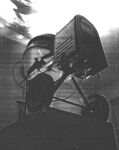 |
1992 ? - The German artist Wolfgang Flatz has built a computer program that is guaranteed to wipe your hard-disk clean. For 390 DM you can buy the standard MS-DOS version. Once started the program shows the artist wielding a hammer and then all your programs and data are obliterated in a matter of seconds. The artist claims the program is resistant against all known virus-scanners. If you want to buy a disk from the special limited Flatz-edition of 20 you will have to pay 1800 DM.
1994 - Mark Bridger (England) tipped a pot of ink into an aquarium containing a fluffy white lamb in formaldehyde, thereby destroying the artwork by Damien Hirst (Away From the Flock, 1994). The white sheep was effectively turned into a black sheep. It cost 1000 pounds to remove the pigment, but Mark Bridger escaped any kind of fine, because of "insufficient means".
1996 - Toronto art student Jubal Brown vomited blueberry yogurt on Piet Mondrian's Composition in White, Black and Red at the Museum of Modern Art in New York. It was, Brown claimed, the second installment of a three-part performance-art protest against "oppressively trite and painfully banal art." Earlier that year, he had vomited tomato sauce on a Raoul Dufy painting; he said he was still looking for an artwork on which to vomit something yellow.
1997 – The Russian performance artist Alexander Brener went into the Stedelijk Museum in Amsterdam and sprayed a green dollar sign on Kazimir Malevich's painting “White Cross on Gray”. This has caused irreparable damage to the suprematist painting (valued at over $6 million) and got Brener a 10-month jail term. Brener claimed that the attack was "a political and cultural action against corruption and elitism in culture."
1998 - Dutch artist Kees Aerts started the Wandering Paintings project. He was inspired by the erosion and decay of deserted buildings, by crumbling frescoes and by old billboards covered with thick peeling layers of faded paper. "Time did it's work here, not human hand. Kees Aerts makes paintings using materials that will be affected by wind, rain, cold, heat and abrasion. "My paintings are allowed to live, by dying."
| 1999 - Swiss artist Moritz Ebinger (1961, Bern) wanted to install a bank-terminal at the foot of the famous church-tower in Utrecht. A visitor keys in a sum of money, which then floats down from the cash-dispenser located on the tower's 70 or 100-metre gallery. The receipt is all that remains of the transaction. | Everyone can speculate about what actually happens to the money - who catches it, or where it might still be floating. Real or imagined, this is everyone's opportunity for a grand pre-millennial gesture. And if there is a bit of a wind, the money can be carried all over the town. (Make My Day) |
| 1999 - Roland Eckelt distributed
15.000 postcards throughout Berlin with the following
text: Ideally the car should be certified, be in a good driving condition and not be older than 10 years. At the moment only one person gave his car to the artists, a Citroen BX from 1987. In just a few seconds this car was ripe for the scrap-heap ... The action was heavily criticised in the German car magazine "Auto Bild" which found the wrecking of fully functional cars distasteful. |
Free yourself from the daily fear and danger of the traffic. Let an artist wreck your car. |
| 2000 - Justin Hoffman has put up posters in Vienna with the following text in large red letters: | Please tear down this poster as soon as you see it ! |
| 2000? - On Stuart
Brisley's website you can select one small field of a big
picture. The selected field is sent to you by e-mail and
it is - permanently - deleted on the original. The
accompanying e-mail says: Hi.
- Here's your Image::copy 32x32 artwork that you chose.
Keep it safe, it's the only copy that exists, as the spot
you chose on the image has now been blacked out. Feel
free to come back and get some more free art. http://www.ordure.org/ - Regards, Rosse. |
Political action and resistance
1956 - An early practitioner of conceptual art in Hungary, Miklós Erdély participated in actions in 1956, and happenings through the 1960s. His "Unguarded Money" consisted of placing boxes in Budapest streets to collect money for the families of political martyrs.
1968 - French artist Daniel Buren critiqued the state apparatus to which artists were submitted by pasting up unauthorised posters made of green-and-white vertically striped paper in 200 outdoor locations throughout Paris. He also enlisted two men wearing sandwich boards (with the same green-and-white vertically striped paper) to parade around the Museum.
1971 - A video footage of the performance piece by the Yugoslavian artist Gotovac shows him running naked through the streets of Belgrade. In the East, the appearance of a naked artist in public had a direct political dimension, as the threat of police surveillance and censorship was constant. Whereas such behaviour might pose challenges to morality in the West, in the East, it bore the mark of anarchy. In several instances artists were arrested, condemned for hooliganism, and accused of anti-social behaviour, a dangerous charge.
1973 - The "Grup de Treball" (Working Group) composed of Catalonian artists used conceptual art to fight the fascist regime during the final years of Franco's dictatorship. For example, In Recorreguts (Distances Travelled) the group traces (on a map of Barcelona) the routes taken by 113 members of the nascent Assembly of Catalonia as they were led by authorities from the site of their arrest to prison.
1975 - The Russian artists Komar and Melamid ground up pages of the "Pravda" state-newspaper, collected its ground up bits and pieces, and created a round, greyish object (Pravda Hamburgers, a performance). They also appropriated twelve types of official papers by which the Soviet regime maintained control over it's citizens, crossed out the text and destroyed the documents distinctive visual characteristics re-presenting them as plexiglass sheets (Ideal Document 1975).
1974 - Sung Neung-kyung (South Korea) scrupulously removed every printed line of a newspaper, discarded them in the trash, then attached the mutilated remains of each page to four panels on a gallery wall. Repeated daily, for the duration of the exhibition, the performance mocked the violent political censorship of the military government by punning on the popular line, "the truth can be read between the lines." (Newspaper: After the 1st of June 1974)
1976 - Some of the photo-performances of Tibor Hajas (Hungary) were both subversive and dangerous. In Dark Flash he hung from the ceiling of a darkened room by a rope which was tied around his hands. Holding a camera in one of his bound hands he attempted to photograph light flashes that occasionally pierced the darkness. At the end of the performance there was an enormous flash of magnesium as Hajas, now unconscious, was released from the rope. - Tibor Hajas, the most important Hungarian performance artist, signaled the end of the conceptual period, preferring risky performances to dry conceptual constructions.
1978 - Ion Grigorescu created several short films and photographic essays that explored his sense of a self fractured by the lies and secret codes required for survival in a totalitarian state. In Super-8 films like Boxing (1977), Man as Center of the Universe (1978), and Dialogue with Nicolae Ceausescu (1978) he records himself in the seclusion of his own room or in a remote field reflecting the utter confinement of his situation. He often used multiple images of himself within the frame to suggest the fragmented self and the elimination of personal identity imposed by the government. (The Romanian artists were extremely isolated in Eastern Europe. Any type of unauthorised public gathering was prohibited and their performances were mostly private actions.)
1983? - Nikita Alekseev started to organize exhibitions in his Moscow appartment. One exhibit that he remembers best was called Victory over the sun. An elegy to the 269 passengers of a Korean plane that was shot down by the Russian airforce after it had strayed into Soviet airspace on 1-9-1983. It consisted of rolls of white, black and yellow paper hanging from the ceiling, filled with texts and drawings, accomapanied by tape-recorded voices. --- There were frequent threats from the KGB.
1984 - In "Pictures from the Dongduchon Photograph Salons" Kim Yong-tae (South Korea) collected (discarded) portraits of American soldiers from commercial photo salons near the local US military base and presented them as art objects in a gallery. The images provoked a reinterpretation of the American presence.
1985 ? - Under the influence of perestroika in the 1980s (under Soviet leader Gorbachev), the power of the Eastern Block state regimes and ideologies eroded. began to crumble. The dramatic political changes led to a crisis of identity that is exemplified by the artist Ceslovas Lukenskas. In his work "A Thrown Out Man" the artist literally throws himself into a pile of rubbish at a dump.
1986 - Dimitri Prigov began hanging his "garbage" on Moscow trees - scraps of paper, all signed by "Dimitri Aleksandrovich":
Prigov was put in a mental hospital by the Moscow authorities. Prigov's artist-friends stood watch in front of the mental institution until Prigov was released.
1990? - The Guangzhou based artist Xu Tan proposes to transform an old colonial house into an underground brothel behind an appearance of a barber shop. This is a common phenomenon (re)emerging in Chinese urbanisation today (The Project of Refurbishment of a House in San Yu Road). - http://www.shanghart.com/text2.htm
1990? - Guangzhou artist Lin Yilin realised an action in the centre of Hong Kong a year before the transition. Using the urban situation of Hong Kong as a background, he "transported" a brick wall piece by piece throughout one of the most congested area in the city. He inscribed tens of names of main Hong Kong political organisations, institutions and companies on both sides of the brick wall. When the wall arrived at the Arts Centre after hours of arduous transporting, the names were totally decomposed into illegible traces on the "reconstructed" wall. - In another action "Manoeuvre across the Lin He Road", against a "background" of a skyscraper construction site, he erected a brick wall on one side of the avenue busy with traffic. Then he transported the wall brick by brick across the avenue. The busy traffic, which is a symptomatic factor of the urban development, was interrupted by the action for a few hours, until the brick wall was transported to another side of the avenue, where another construction site was also at work. - http://www.shanghart.com/text2.htm
1991 - Shi Jian and Chen Jue's Tiananmen Square, a series of tapes filmed in the neighbourhoods around the square in Beijing where historic student uprisings occurred in 1989, were banned by the Chinese government from domestic and international distribution until 1997 when they were shown at New York's Museum of Modern Art.
1993 - Kendell Geers engaged in actions which questioned political reality in South Africa. In "Untitled (ANC, AVF, AWB,CP, DP, IFP,NP,PAC, SACP)" a work generated in the chaos that ravaged South Africa in the months leading up to the country's first democratic elections, Geers joined all the official parties of South Africa, including ultra right-wing Afrikaner parties, to claim false identities and at the same time make them suspect beyond measure.
| 1997 - Over 60,000 human-sized hands were planted on wire sticks in the Parliament House lawns in Canberra as a symbolic show of hands by thousands of Australians. The Sea of Hands was designed as a message from Australians to the world that, as a national community, they support coexistence that they respect the rights of indigenous Australians. Each hand represents a person who has signed the Citizen's Statement supporting the continuation of Native Title and opposing the proposed changes to the legislation. Each signatory's name is printed onto a model hand and incorporated into the vast, swirling, colourful pattern of hands, a statement of recognition of the crucial significance of land and sea to indigenous Australians. As the artwork travelled through Australia the number of hands grew to 100.000 (Melbourne Gardens) and 250.000 (Sydney Beach). | http://www.nla.gov.au/cgi-bin/images1/pic?19951+d |
2001 - Damian Ortega has reserved a field of grass in the middle of the busy motorways of Porto (Portugal). Visitors can buy a voucher for 10 Euro in the gallery. The money will be used to plant trees and absorb the CO2 emissions.
1950 > In his teens Fakir Musafar re-enacted the rituals of primitive people in the basement of his parents' house and experimented with self-piercing, self-tattooing, enlargement of his piercings, sewing weights or attaching clothespins or clamps to his body, and performing extended trials of endurance such as dancing for hours while wearing heavy chains. One of his favorite practices was the waist-binding practice of New Guinea, in which a tight band is worn day and night around the waist to create a permanently shrunken waist. Since then, Fakir has continued with his research into world-wide ritual practices. As well as continuing with the practices of his youth, he has sealed all the openings in his body, hung by fleshhooks through the healed piercings in his chest and temporarily elongated his penis and scrotum using hanging weights or metal rings. Two of his most spectacular feats, involve the recreation of specific non-western rituals. The first is the Native American Sun Dance, in which the subject is attached to a tree from a piercing in the chest, and cannot leave the tree or quit the dance until he has freed himself by ripping the skin by which he is attached. The second is the Indian Kavandi-bearing ritual, in which the subject wears a framework of sharp rods stuck into his skin. As the bearer rises and moves around, his motion drives the rods deeper into the skin.
| 1968 > In the period 1968 - 1978 Paul
Mc Carthy designed and executed a long series of
performances. Many of these are creative, unexpected,
spectacular and adventurous. They are very suitable for
the deserted buildings. He called them
"Instructions". The ones I like most are: |
|
1969 - Trisha Brown's works were designed to disorient the audience's sense of gravitational balance. In one of the works a man, strapped in a mountaineering harness walked down the vertical wall-face of a seven-story building in lower Manhattan ("Man walking down the side of the building").
1969 - In the film See-Through Vito Acconci boxes with his own reflection in the mirror until the mirror breaks. With the disappearance of his own reflection, that of the space also disappears. The depth of the image in the mirror changes into a flat surface. In another video Acconci boxes with his shadow until he falls exhausted to the ground. While falling, he drags along his "opponent" with him. (Three relationship studies, 1970) In the film Zone (1971) the artist walks in circles around a (moving, and presumably irritated) cat for half an hour.
1970 - Dennis Oppenheim lay in the sun for a three-hour period at Long Beach, California. With an appropriately titled book on his chest, Oppenheim "painted" his body with deep brown sunburn. The rectangle where the book was placed retained the pink skin tones of an academic. - Other sources speak of Jones Beach and 5 hours. - Dennis Oppenheim: - I allow myself to be painted - my skin becomes pigment. I can regulate its intensity through control of the exposure time. Not only do the skin tones change, but change registers on a sensory level as well. I feel the act of becoming red. - Duration of exposure: 5 hours. (Reading Position for Second Degree Burn)
1970 - Dennis Oppenheim put his body in danger by hanging in the void from a collapsed concrete casting between the Brooklyn Bridge and Manhattan. (Parallel Stress)
| 1971 - The video Dynamic Field Series features Peter Campus in his studio engaging in a set of self-imposed feats of endurance, like climbing a rope, while the camera engages him from so many different angles that the viewer is never sure what is real or imaginary. But in fact Campus lies on the floor, his body appearing to advance, recede and spin as he raises and lowers a camera suspended overhead from a pulley. The viewer is subjected to a dizzying spatial disorientation as Campus seems to revolve. Finally, he wraps the camera in cellophane, then uses scissors to cut it away, creating a startling, transformative illusion. | 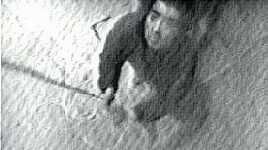 |
1971 - Prelude to 220, or 110 was performed at F-Space in Santa Ana, California, September 10 through 12, 1971. Chris Burden was secured to a concrete floor with copper bands for two hours during each of the three days of the performance. Beside him were two 110-volt lines immersed in buckets of water. The possibility was immanent that a spectator would spin the contents of the buckets and electrocute Burden.
| 1971 - Chris Burden's description of his best-known piece, "Shoot", performed in 1971, reads as follows: "At 7:45 p.m. I was shot in the left arm by a friend. The bullet was a copper jacket 22 long rifle. My friend was standing about fifteen feet from me". | 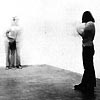 |
 |
| 1971 - Bas Jan Ader died at the age of 33 in 1975 during a performance piece in which he attempted to cross the Atlantic Ocean in a 13-foot sailboat. Like many of his contemporaries, Ader used photography to document his performances. In one such project, titled FALL, Ader photographed and filmed his own body falling from a tree in a meadow, from the roof of his California bungalow, and from the bank of an Amsterdam canal. | 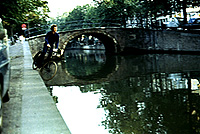 |
 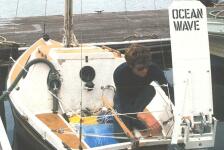 |
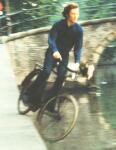 |
1971 - Dennis Oppenheim was standing still inside a 5-foot-diameter circle. A person above him was throwing stones inside the circle while a movie camera was recording the artist's facial expressions. This action had to be interrupted before the artist expected. (Rocked Circle-Fear)
1971 - Gina Pane's various 'Projets de
Silence' include the following: beside a river covered
with a white sheet, wash one's hands in a bowl of boiling
chocolate which a member of the public will then drink,
undertake blindfold a dangerous pathway, force oneself to
spit until one is spitting blood; slash with a razor
blade the shoulders, the sides and the fore-arms as if
profanely mimicking ancient rituals, which people can
interpret according to their taste as a communion
service, an initiation rite, ritual auto mutilation etc.
- Picture shown: Body transformation - Nourriture:
the slow and difficult absorption of 600 grammes of
minced meat which disturb the usual digestive operations
|
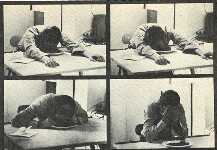 |
1971 - In Frankfurt, Germany, Jochen Gerz used his fingers in place of chalk or pencil repeatedly to inscribe this sentence on a wall: These words are my flesh and my blood. Finally real blood began to ooze from his fingers and to leave visible traces on the wall.
| 1971 - In his Inside the Harlequin series Howard Fried (California) anticipated some video-works of Matthew Barney twenty years later. In this series of videos, presented in multi-screen projections, Fried scales the walls of his studio with the help of suspension wires and harnesses. He presents the studio as a place to be entered fully and conquered. (Inside the Harlequin: Approach-Avoidance I, II and III) | 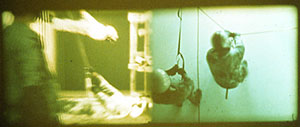 |
| 1971 - Dennis Oppenheim stood
in a five-foot-diameter circle for half an hour while a
collaborator on the third floor of an adjacent building
dropped rocks into the circle. There were no direct hits,
but they were close enough to inspire fear; a video
camera captured his changing facial expression under the
impact of the surges and ebbs of feeling. As I stand in a five- foot diameter circle, rocks are thrown at me. The circle demarcates the line of fire. A video camera is focused on my face. The face is captive, its expression a direct result of the apprehension of hazard. Fear is the emotion which produces a final series of expressions. (Rocked Circle-Fear) |
 |
1972 - Petr Stembera started his first actions in physical endurance: progressively increasing the number of days without eating, drinking, or sleeping; studying his muscular resistance by contracting his neck and face muscles; or grafting a rose onto his arm, an operation that gave him an infection.
1972 - Chris Burden's piece "Deadman" was another all-too serious game with death. He was rolled in a tarp and he lay in the middle of a busy of a busy Los Angeles boulevard. Luckily he was unhurt, and the police put an end to the work by arresting him for causing a false emergency to be reported. In other performances, Burden had pushpins stuck into his stomach (Back to You, 1974), tried to breathe water (Velvet Water, 1974), and remained on a shelf mounted just below the ceiling of a gallery without descending to eat or drink for twenty-two days (White Light/White Heat, 1975).
1973 - Gordon Matta Clark climbed to the top of the Clocktower in New York and washed, shaved and brushed his teeth in front of the clock. (Clockshower 1973)
1973 - Holding his hands behind his back Chris Burden crawled through 50 fleet of broken glass on September 12, 1973. He was naked except for briefs. There were very few spectators, most of them passers-by. The piece was recorded on 16mm film. The resulting film is both beautiful and terrifying. (Through the Night Softly - Main Street, Los Angeles)
1973 ? - Chris Burden placed a bed in his gallery and stayed in that bed for 22 days. (Bed piece)
1974 - The actions of Jan Mlcoch (Czech Republic) are generally of a symbolic character. However, pain and risk are often present in his work: in 1974 he pricked his whole body with a needle so that the sun's rays could penetrate it better; also in 1974 he hung from a steel beam, his wrists and ankles tied with a rope.
1974 > Peter Dreher has painted more than 3000 pictures of one and the same glass. Every picture shows the same glass on a table in front of a white wall. The lighting is artificial and constant. Still, every picture is different. The artist: I wanted to see what happened if I kept on painting the same motif. I thought four or five paintings would be enough. I didn't expect it would become more and more fascinating. The subject doesn't change, but the painter changes and his changes are recorded in the paintings.
1974 - For Sculpture in Three Parts Chris
Burden sat on a small metal stool in the Hansen-Fuller
Gallery. The stool was placed on a sculpture pedestal in
front of the gallery entrance, and elevator door. A sign
on the stand read:
|
The artist sat in the chair for forty-three hours.
After he fell, a chalk outline was drawn on the floor
around his body. He wrote "forever" inside the
outline. Then he placed another sign on the stand, which
read:
|
1975 - Bas Jan Ader died at the age of 33 in 1975 during a performance piece in which he attempted to cross the Atlantic Ocean in a 13-foot sailboat. For this piece, IN SEARCH OF THE MIRACULOUS, he set sail from Cape Cod on July 9, 1975. Undertaken with every expectation of success, Ader had arranged for a show documenting the feat at the Groeninger Museum in Amsterdam, and planned to exploit the success of the 60-day crossing with further exhibitions of material--diaries, film, photography--generated by the piece. Ader never reached his destination. Six months later his boat was found half-submerged off the coast of Ireland.
| 1975 ? - COUM Transmission explains: | In actions I initiate tasks of real pain are overshadowed by theatrical tricks that look more real, more bloody. For example, I drink a pint of milk, a pint of blood, a pint of urine that I have passed in front of spectators, my foot rests on a bed of nails that are sinking into my foot, but the spectators have forgotten that because they are focused on the obvious taboo of drinking urine. I will insert unsterilized needles into my veins, this shocks but I leave them there so long that people forget that they are real and causing pain; they see them very quickly as decoration. So I use the real and the trick to provoke a question of response and manipulation of response. I get no masochistic pleasure from my risks, but I get the satisfaction of facing up to my fears and relinquishing inherited and to me false taboos and neuroses in a way that offers a system of revelation and education to a percentage of bystanders. |
1977 - Stuart Brisley moved to distant part of Kassel (during the 1977 Documenta) dug a hole by hand and lived at the bottom of it for a period of two weeks - "survival in alien circumstances"
1977 - Kerry Trengove tunneled his way out of a small sealed space in the foundations in the Acme Gallery in London - it took him eight days to emerge into the daylight. (An eight day passage).
| 1980 > Danny Devos has done many great performances with an Urban Adventure touch: |
|
1981 > Ilya Kabakov made an installation about a "Man who flew into space from his apartment". The installation shows a tiny living-room with a bunk bed and a slingshot construction with springs and slings. On the walls are designs for rockets and catapults. There's a gaping hole in the ceiling. It suggests a home-brew experiment that went all too well.
| 1981 - Tehching Hsieh spent a year outdoors on the streets of New York, during which he got arrested and spent a night in the cells. For other projects he remained in a cage for a year, punched a time clock every hour on the hour for a year, tied himself to Linda Montano with a rope for a year. His current performance involves not looking at, making, reading about, or talking about art for twelve months. http://www.one-year-performance.com/ | 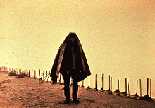 |
| 1983 - Bill Viola confined himself to a room in a house where he attempted to stay awake for three days. The taped chronicle of this self-imposed entrapment, Reasons or Knocking at an Empty House, illustrates how harsh the passage of time can be. | Viola writes that this work is an attempt to stay awake continuously for three days while confined to an upstairs room in an empty house. Recordings were made from a stationary black and white camera to chronicle the effects of the relentless passage of time on a solitary individual. The space becomes increasingly subjective as events slide in and out of conscious awareness and the duration becomes more and more brutal." Subtle transformations in light and sound, and the use of a wide-angle lens to create spatial ambiguities, further distort the viewer's perception of time and space, illusion and reality. |
1985 - Graffiti artist BLADE made a
painting containing the names of living and deceased
writers. He added the following comment:
|
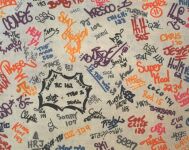 |
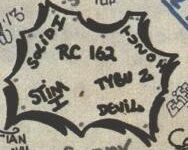 |
|
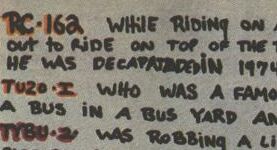 |
1986 > Performance artist David Leslie was inspired by American folk heroes like Evel Knievel, James Brown and Bruce Lee to perform several dangerous art-stunts. Most of these were published as videos that are for sale:
1987 - In his early video works Bruce Nauman often used the clown figure to illustrate the artist's interest in language and the extremes of human behaviour. In one video the clown in was forced to stand on one leg, and at another time, to balance two fish bowls and a bucket of water, all the while shouting 'No, no, no,' and 'I'm sorry, I'm sorry,' over and over. (Clown Torture)
| 1990 - Wolfgang Flatz was swung between two steel plates for five minutes emulating a human church-bell. In the meantime a couple were dancing to the music of the "Kaiserwalzer" by Strauss (Demontage IX). Other actions by Flatz included being used as a human towel in a public toilet, lying in front the art-academy door wrapped in a carpet an being stepped on by students and teachers. In 1979 visitors to the gallery in Stuttgart were invited to throw darts at the naked artist. A good shot (that hit the artist) was rewarded by DM 500,-- in cash. (Treffer). | 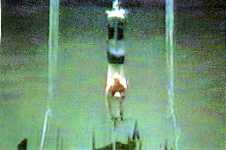 |
| 1990 - One of Stelarc's performances includes hanging from hooks pierced through his skin. Reportedly the artist picked up the idea of hanging by fleshhooks by seeing pictures of hookhangers in Ceylon. Usually he chooses high places (several floors high) for this performance. The other performances of Stelarc focus on the cybernetic integration of man and machine. He has developed an working, artifical, third hand and has made a technological sculpture that can be inserted into his stomach. http://www.stelarc.va.com.au/ | 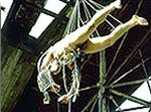 |
1991 - In Matthew Barney's video-work "Mile high threshold: Flight with the anal sadistic warrior" there is the thrill of watching the artist, naked except for a full body harness and a collection of titanium ice screws, clambering up the gallery walls and attempting to cross the ceiling by swinging upside down from one support to the next. In his "Drawing Restraint" series (1988) the artist wanted to defeat the facility of drawing through the application of arbitrary, self-imposed restraints. The artist would negotiate ramps and inclined boards while tied to elastic cords, jump trampolines and push sleds in order to trace a line on the wall or ceiling. He also would attempt to draw with instruments that were too long or impossibly unwieldy to work with. The idea was that the strength of a work is proportional to the hardships overcome to create it.
1993 - Olav Westphalen has mastered the art of being a professional amateur. "One thing I like to do is to go into a situation as a "dilettante" - someone who isn't very well-prepared, but who has a basic plan and curiosity and then sees what happens." His attempt to cross the Atlantic on styrofoam shoes, using a wetsuit, helium balloons, and crutches failed, as was to be expected. "I know what I did wrong. I was standing much too high. And also, it was much too choppy. In theory it could have worked - at least in my theory, which wasn't very informed." (Walking on the Water) http://hotwired.lycos.com/gallery/96/43/profile.html - http://hotwired.lycos.com/gallery/96/43/index4a.html
1994 - Mona Hatoum made her most famous work, the Corps étranger. This video installation immerses viewers in a claustrophobic barrage of unrecognizable images and unusual sounds. It takes a moment to realize that the sounds are actually magnified recordings of human internal organs, and the images are endoscopic photographs of the artist's own insides.
1995 - New York artist Michael Joseph is dangling from the ceiling by a harness. A series of white cords are strung across the room and attached to a control panel. The control panel labels for each cord - leg, knee, hand, etc.- and allows the viewer to operate the artist/marionette by adjusting the cords (i.e., raise both knees into the air, lower right arm to pick up a tin cup, etc.). The body of the artist is seemingly at the mercy of his audience. (Proxy)
1996 - Lynn Tondrick intended to create a space that was antagonistic toward the viewer. To create a place where the spectator would have to make a sacrifice to truly experience the work. A place where the work would take blood. Therefore 800 mosquitoes were ordered from Carolina Biological Supply Company in larval and pupal states to be raised to maturity. But they did not bite. (Mosquito Room) http://www.zingmagazine.com/zing3/reviews/003_tondrick.html
| 1999 - Early in the morning on the 4th of July, Job Koelewijn executed a performance titled Panorama 3000. On the highest point of the Domtower a man was hanging with a mirroring cube on his head. The mirroring cube reflected the surrounding sky as the man hung between heaven and earth. The man was not be able to see far, on the contrary, he will see nothing. His outlook is changed into the reflection of the surroundings. | Initially Job Koelewijn envisioned an enormous magnifying glass above a busy square or street. He researched the possibilities of a synthetic lens, ten metres in diameter. The spectator would see a magnified picture of so large that the view would be obliterated. Unfortunately, the plan was technically impossible. |
| 2000 - Job Koelewijn transformed the space of Chisenhale Gallery by installing a false floor and ceiling. Large circular trampolines are sunken into the floor, each corresponding to a black hole in the ceiling above. The work combines a formal visual elegance with the allure of physical experience, seducing us to participate in the work which is incomplete without our involvement. As you bounce on the trampolines, your head briefly enters the area above the false ceiling and gives you a revelatory glimpse into an unexpected physical and mental space. | "The black hole above your head becomes a special place to aspire to. Using the trampoline when you have the gallery to yourself is an exhilarating experience." |
| 2001 - From 3 to 10 March 2001 San Keller will stay in the Swiss town of Luzern. He will live without organized meals, shelter, work and without money. His only possessions are his clothes, a pocket-knife, a ball-point pen and his train-ticket (Zurich - Luzern - Zurich). He will stay within a circle of 1 km around the UG-gallery. At the same time UG-gallery will become a public area for the population of Luzern. The gallery remains open for 168 hours on end. A food vending machine, a seat, a wastebasket and an ashtray are provided for the visitors. The area is checked regularly by security-guards and will be cleaned every morning by personnel of the Luzern theatre. Are you ready for San Keller? Try to find him in the city or wait for him in the UG-gallery! Try to interact with his action! (San Keller homeless in Luzern) http://www.value-konzepte.ch/san/san_projekt.html | 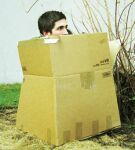 |
Infiltration - of personal and public spaces
1956 - A performance by Ken Friedman:
|
On the first day of Spring, go unannounced to a public monument. Clean it thoroughly. |
1969 - The Slowak artist Goran Trbuljak made the artwork "From time to time I stuck my finger through a hole in the door of the Modern Art Gallery without the management's knowledge". The title says it all.
1969 - In Following Piece Vito Acconci would choose at random a person on the street and follow him wherever he went, no matter how long or far, until that person entered a private place. The next month Acconci mailed out typewritten reports on different day's outings to about two dozen figures in the New York art world. At 7:28, he entered the Italian Kitchen, 124 East 14th Street. At 8.10, he entered the Academy of Music movie theatre, 126 East 14th Street At 10:05, he left the theatre, after seeing only parts of both movies; he walked east on 14th Street At 10:23, he entered a building, 534 East 14th Street, between Avenue A and Avenue B. (Following Piece) "Those following pieces varied from six-minute episodes, when someone would get into a car and I couldn't follow, to four and five-hour episodes, when someone went to a movie or restaurant."
| 1970 - In the informal ambience of a museum Vito Acconci sporadically performed a piece in which he sidled up to spectators and stood uncomfortably close to them until they moved away (Proximity Piece). | Standing near a person and intruding on his/her personal space. During the exhibition, sometime each day, I wander through the museum and pick out, at random, a visitor to one of the exhibits: I'm standing beside that person, or behind, closer than the accustomed distance. I crowd the person until he/she moves away or until he/she moves me out of the way. | Attached to the wall, in the midst of the other exhibits, a 3 x 5 inch index card notes the activity and describes it as above; the card might or might not be noticed by a viewer passing by. |
1970 - In - Reverse Processing - Dennis Oppenheim trespassed at night onto barges in the East River that carried unrefined cement from a cement factory and inscribed huge,white, cancelling X's in each barge in refined cement powder.
| 1971 - Chris Burden performed the Five-Day Locker Fiece, which marked the beginning of his major work. The piece was executed in partial fulfilment of his master's degree at Irvine. Word spread quickly on the campus. Students from all over the campus came to the locker to see what was going on. Professors from the art department held classes in front of the locker, including Burden in the discussions. | About 10:30 PM the doors were locked and people could no longer come into the building. That was the most frightening period. I had this fantasy, though, that I could always kick the door out. Some nights my wife would sleep on the floor outside in case I really flipped out or something. It was pretty strange. One night the janitor came by and he couldn't figure out what she was doing there. |
| 1977 - Robert Filliou performed a series of playful but formally illegal acts in major museums in Paris. At the Louvre and the Musée d'Art Moderne, Filliou quietly approached paintings and sculptures, and cleaned them. Filliou had his actions photographed, and the snapshots, dust-rags, and precious particles of dust from each were placed in official-looking archive boxes. He removed a (symbolic) coating of dust from the ancient art objects, while creating a modern piece with the resulting accumulated dirt. (Poussière de Poussière, Dust to Dust) | 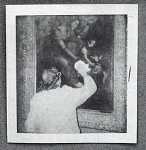 |
1979 - Sophie Calle invited 45 friends, neighbours and strangers to sleep in her bed and documented these meetings in photographs and texts (The sleepers)
1980 - In the early 1980 Sophie Calle assumed a succession of detective characters, always watching, seldom seen:
1990 ? - French photographer Luc Delahaye spent two years photographing strangers in the Paris Metro. "Apart from the odd illicit glance," writes Delahaye, "you keep staring at the wall. You are very much alone in these public places and there's violence in this calm acceptance of a closed world." In the book, Delahaye says he "stole" the images.(L'Autre -The Other)
1990 ? - Gillian Wearing's interest was piqued by a woman on the street whose face was covered with gauze. The artist wanted to ask the woman about her life, but shyness would not let her approach the masked woman. Later, still thinking of the mysterious woman, Wearing covered her own face with a bandage-like mask and videotaped people's reactions on the street, creating Homage to the Woman With the Bandaged Face.
| 1993 - One project of the Berlin duo p.t.t.red, consisted of the two men wandering for two days through a Bavarian National park dressed in enormous bear suits (Wimbachtal, Nationalpark Berchtesgaden). Encounters with astonished tourists resulted in an article in a German newspaper with the headline: "Bears back in Germany." But the last bear in Bavaria had already been shot in 1910. Therefore showing themselves outside the protected park-area might have been lethal. They could have been shot by an overenthusiastic trophy hunter. (Ursa in Orbit) http://www.members.aol.com/pttred/art/zen.htm - http://www.members.aol.com/pttred/art/ursain.htm - http://www.bewer.de/kvn/programs/pttred2000.html |  |
1993 - During
the winter of 1993-94, an unofficial men's club opened in
an apartment building on Wall Street. Peering across an
air shaft and through a bathroom window, Merry Alpern
took pictures of the prostitutes and their clients. The
black and white pictures are grainy, strange and
indistinct. The viewer must try to make sense of them, to
reconstruct stories from blurred lines and sheds of
fabric:
|
 |
| " The New York winter of 1993-94 I spent most of my nights that winter down on Wall Street looking into a bathroom window, watching people I didn't know urinate, take drugs, have sex and count money. I used to have a recurring dream, it went like this: I am spying on some activity in the window when, suddenly, the subject becomes aware of my presence and looks up. We lock eyes. I know I'm in big trouble. I gasp and wake up." http://www.sfcamerawork.org/books/1881616584.html http://fototriennale.mur.at/alpern.shtml |  |
| 1993 - Christian Philipp MUELLER - Disguised as a hitchhiker, MUELLER left Austria and crossed the borders to all neighbouring countries. The work took on more sinister political implications when he was arrested by border control guards in Czechia. (Green Border) | "I left Austria unnoticed and went to eight neighbouring countries: Italy, Switzerland, the Principality of Liechtenstein, Germany, Czechia, Slovakia, Hungary and Slovenia. I used maps produced in Austria (scale: 1:50000) and tried to find wooded areas near the borders. In Czechia my Polish assistant and I experienced the difference between the border as an artistic concept and political reality. For more than two hours nobody prevented us from taking photographs and walking around freely. Suddenly, however, we were seized by frontier patrolmen and got a stamp in our passports that forbids us to re-enter the country within the next three years." |
1995? - Mexican-born conceptual artist Gabriel Orozco opened downtown Antwerp's Galerie Micheline Swajcer to the public. Car drivers unable to find a parking space on the city's crowded streets could park their cars in the gallery.
1995 - Ulf Lundin (Sweden) spent a year spying on the family of one of his friends. He did this under the terms of a contract that said that Ulf was allowed to photograph his friend and his friend's family, so long as he remained invisible. For over a year, Ulf Lundin spied on this man and his family, snatching shots through his windows, from behind the bushes in his garden, or hidden in his neighbour's house. Lundin even followed the man on weekend-trips and on his summer holiday. He recorded more than 100 rolls of film.
1996 - In the night of 25.6.1996 the Berlin artist-duo "p.t.t. red" (Stefan Micheel, HS Winkler) manipulated the lighting of the Statue of Liberty. The statue lit up red for several hours (other reports say minutes). (Red Statue of Liberty) They repeated this action in Berlin where they manipulated the lighting of the "victory column" (Red 2, Siegessäule). - http://www.bewer.de/kvn/programs/pttred2000.html
1997 - Katarzyna Kozyra (Poland) used a hidden camera to shoot pictures of women in one of Budapest's public baths, during their most intimate activities (washing, drying, rest) while they remained completely unaware that they were being filmed. Some of these shots expose the old and exhausted female body, so different from the ideals that we are accustomed to see. http://www.absolutearts.com/artsnews/2001/01/28/28004.html
| 1997 - Merry Alpern's book, Shopping contains pictures of shoppers that were taken with a miniature surveillance camera without the knowledge nor the consent of the subjects. The video-camera was hidden in the purse of the artist and was filming all the time. At home the artist selected the best shots and transformed them into stills. Many of the pictures show women in try-on rooms and show the mismatch between ordinary bodies and stylish clothes: upper thighs dimpled with cellulite, thongs on women who should not be wearing them, and a misshapen old women struggling into bathing suits. http://www.walkerart.org/programs/andersen/hopper/alpern.html http://www.bonnibenrubi.com/Alpern/alpern.html |  |
1997 - In the summer of 1997, Kurt Caviezel took pictures of the interiors of cars stopping at the red light outside his apartment on busy Zurich intersection.
1997 - Bernhard Huwiler uses a 40-pound
backpack filled with blue sand, which trickles out behind
him as he walks. Gerald Smith follows with a video camera
on a stick, recording the journey. The collaborative team
uses this tool to create several very large drawings,
either of a straight line through the city, a spiral
around Uptown or their signatures in a large field.
http://www.mndaily.com/ae/Print/1997/20/st/fespace.html - http://strikingdistance.com/sd9705/c3i_3/drawing1.html |
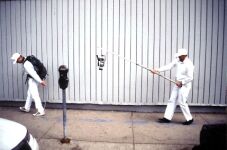 |
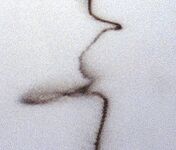 |
| 1999 - Allan Sekula swam close to the house of Bill Gates. With an underwater camera he took pictures of the house, the landscape and of himself. The pictures are taken from the low perspective of a drowning person and show a lot of water and threatening waves. Allan wanted to show the feeling of people involved in the "old economy" that's being overtaken by the new - information - economy. A letter for Bill Gates is also part of the artwork: | "Dear Bill Gates, I swam past your dream house the other day but didn't stop to knock. Frankly your underwater sensors had me worried. I would have liked to take a look at Winslow Homer's painting "Lost on the great Banks" (...)" |
1999 - Arthur Kleinjan (from Holland) made a series of large photo works called "Paris Looks". He made pictures of tourists while they were posing for a snapshot. As the tourists were having their picture taken from the front, Arthur made a picture of them from behind, without them noticing. The viewer is invited to speculate about the social context and relationship of the tourist with his tourist-companions. (Paris Looks)
1999 - This summer San Keller invited the audience in six cities to one night on the doorstep of art. His guests had to spend the night in front of the Kunsthaus in Glarn or the Kunsthalle in Bern. While meeting art they also met the police. - http://www.uni-giessen.de/diskurs/diskurs_99_-_groups___san_kell.html
| 2001 - Laura Blereau has made a video-tape as an homage to Vito Acconci. Here she mimics Acconci’s month-long conceptual artwork "Following Piece" (1969) in which the artist followed one random person in public daily. Building on Acconci's system of merging public space with privacy, "Following Vito" documents one woman's obsession with the 62 year-old artist and her own act of following him in the neighbourhood of DUMBO Brooklyn. With the intent to demystify commonplace media coverage of famous people's lives, this is a true story about desire, identity and surveillance. She writes: | 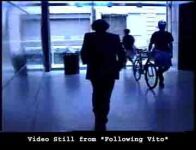 |
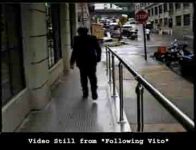 |
| I was lucky to have Mr. Acconci view the completed project in November. I was introduced to him by a friend (who knew my obsession) at an art gallery opening. When I told him about my project, he was receptive, so I decided to go all the way with it. I started my following of Vito by first looking through his garbage. I hoped to find his aura. Once I got the courage, I found him. | 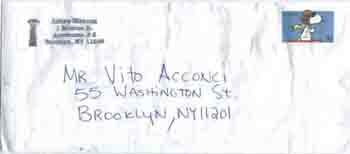 |
|
| 2001 - San Keller sleeps in your workplace. Use this unique opportunity and let San Keller intervene in your daily work routine. Hire San Keller as a sleeper in your enterprise, while you work. With a sleeping San Keller at your side you will enter a surprisingly new and unusual work situation. Leave yourselves be inspired by this adventure! Details such as sleeping location, sleeping period, sleep duration, salary etc. will be determined with the artist. The agreements are laid down in a work and/or a sleep contract. |  |
| 2001? - The 9th of November is the day that the Berlin Wall fell. The Berlin Wall Memorial is the only place in Berlin, where there is still a hermetically sealed field between the two walls. An apparently unguarded no man's land that made the crossing of this remaining obstacle possible. 12 years ago one this act would have been a crime and one would have run the risk of being shot by border guards. Today it is a stage for a quiet act. (Flucht über die Restmauer) - http://members.aol.com/stmicheel/info.htm |  |
 |
 |
| 2002 - Bruce Nauman's large-scale video installation records the nocturnal activity in the artist's studio of his cat and a plague of mice during the summer of 2000. - Seven video projections show parts of Nauman's studio. The viewers can hear the the mice, Nauman's prowling cat, moths, and a screen door, and other sounds indicative of the studio's rural setting. - The viewers sometimes catch a dark flash of movement as a rodent speeds across the floor, with the occasional profile of the cat or its striking head-on image, eyes glowing as it pauses in its chase. (Mapping the Studio I - Fat Chance John Cage) | 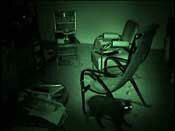 |
| 2002 - Sam Bern (Paris) writes: - I have been working on the boundary between the readable and the unreadable for several years. What interests me in the writing, in a text, it is its physical aspect, its aesthetic rather than its meaning. For example in "Trust/Crust" I’m not interested in the semantics. It is the visual and sound resemblance which is interesting. - I use stencils, stickers and even acrylic paint in the city. The work is composed of gestures that evolve into an allegory of writing. When I paint on the ground I work at night and I use a brush and acrylic paint and I try to select interesting places and surfaces. - Gradually, not being able to deny the presence of the homeless “clochards”, I decided to paint directly next to them during their sleep in order to communicate some of my research to them. - When I see these photographs I’m struck by their positions. On many photographs there is a similarity in their body-positions and my signs. It is not the social aspect that interests me most, although it is certainly strongly present. | 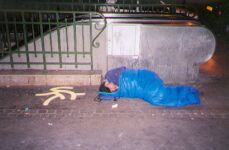 |
 |
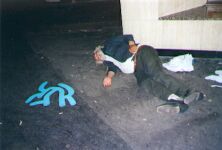 |
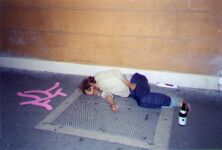 |
Back to: Urban Adventure in Rotterdam
© 1999 - 2005 Petr Kazil